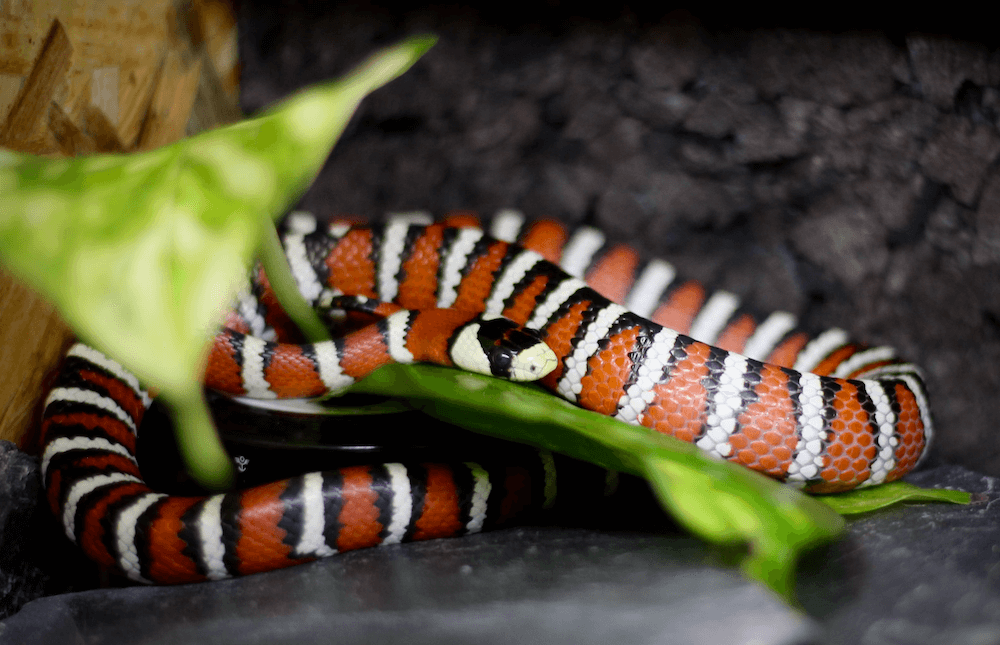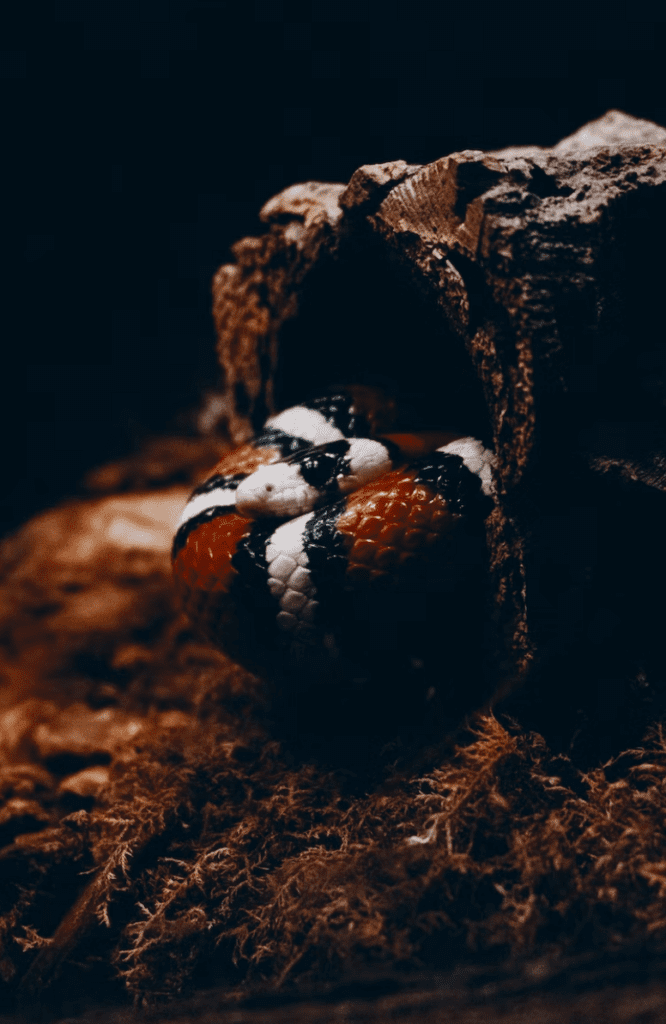Coral snake vs king snake.
Do you know the difference between a king snake and its friend, the coral snake?
Let’s discuss the differences between these two snakes so that you can stay safe, and be better informed in case you ever encounter one.

The venom of a coral snake is neurotoxic, which means it attacks the nervous system while the venom of a king snake is cytotoxic, which means it attacks the cells.
Coral snakes and king snakes are often confused with each other due to their similar color patterns of red, black and yellow/white bands.
Key differences between these King Snakes and Coral Snakes:
Coral Snake
- Highly venomous; neurotoxic venom can cause respiratory paralysis.
- Red bands touch yellow bands. The rhyme “red on yellow, kill a fellow” helps identify it.
- Head is black with a yellow band behind it.
- Found in the southern US and Mexico.
King Snake
- Nonvenomous; subdues prey by constriction.
- Red bands touch black bands. The rhyme “red on black, friend of Jack” helps identify it.
- Some varieties have white or yellow bands right next to the head.
- Found throughout North America.
Other differences:
- Coral snakes have round pupils vs king snakes’ oval pupils.
- Coral snakes have a blunt black snout vs the pointed snout of king snakes.
- King snakes are larger, ranging 3 – 6 ft, while coral snakes are 2 – 4 ft.
So in summary, the main identifying features are the band color patterns and remembering the rhymes about those patterns.
Proper identification is important given the coral snake’s dangerous venom.
Explain It To A Child
Both snakes are poisonous, but their venom affects different parts of the body. The venom of a coral snake is neurotoxic, which means that it harms the nervous system. The venom of a king snake is cytotoxic, which means it harms tissue.
So while king snakes are not immune to coral snake venom, they are less likely to succumb to its effects because their venom targets different parts of the body.
What is the difference between a coral snake and a king snake in appearance?
Coral snakes and king snakes are both brightly colored, but there are several ways to tell them apart.
- Coral snakes have red, yellow, and black bands that are of equal width, while king snakes have black bands that are narrower than the bands of color.
- Additionally, coral snakes have elliptical pupils, while king snakes have round pupils.
- Finally, coral snakes have a head that is the same width as their body, while king snakes have a head that is wider than their body.
While these snakes may look similar at first glance, there are several distinct physical differences between them.
Coral snake vs king snake venom differ
Both snakes are also known to be poisonous, though their venoms differ in both composition and effects.

The venom of a coral snake is primarily neurotoxic, while the venom of a king snake is mostly cytotoxic.
This means that the venom of a coral snake primarily targets the nervous system, while the venom of a king snake is more likely to cause tissue damage.
In terms of effects, the venom of a coral snake is generally less dangerous to humans than the venom of a king snake.
This is because the coral snake’s venom is less easily absorbed by the body, and it is also less likely to cause an allergic reaction.
However, both venoms can be deadly if not treated promptly.
If you are ever bitten by either type of snake, it is important to seek medical attention immediately.
What are the dangers of coral snake vs king snake?

King snakes and Coral snakes are both native to the Americas, but they couldn’t be more different.
- Coral snakes are highly venomous, while king snakes are not.
- Both types of snakes are capable of delivering a deadly bite, but only coral snakes have the ability to inject their victims with venom.
- This makes them a much greater danger to humans and other animals.
- King snakes may be harmless, but they can still deliver a painful bite.
- Coral snakes, on the other hand, pose a much more serious threat.
Their venom is highly dangerous and can cause serious illness or death. If you encounter either type of snake, it’s best to err on the side of caution and stay away.
How to identify a coral snake and a king snake

Both coral snakes and king snakes can be found in parts of America, Central America, and many South American countries. They are often confused for each other and can be difficult to tell apart.
One way to tell them apart is by their color patterns.
Coral snakes have alternating bands of red, yellow, and black, while king snakes have bands of black and white.
Another way to tell them apart is by their size.
- Coral snakes average about two feet in length, while king snakes can grow to be over six feet long.
- Coral snakes have round pupils, while king snakes have oval pupils.
Although they can be difficult to tell apart, it is important to be able to identify both coral snakes and king snakes, as coral snakes are venomous while king snakes are not.
What to do if you encounter either coral snake vs king snake?
If you encounter either a coral snake or a king snake, the best thing to do is to walk away slowly and avoid making any sudden movements.

Both types of snakes are non-aggressive and will only attack if they feel threatened.
If you must pick up either type of snake, be sure to use gloves or a long stick to avoid getting bitten.
Finally, if you are bitten by either a coral snake or king snake, seek medical attention immediately as their venom can be deadly.
While encounters with these snakes are rare, it is always best to err on the side of caution and take steps to avoid them.
So, now you know the difference between coral snakes and king snakes. Remember to stay safe and avoid coral snakes if you see them in the wild!
Article Sources
Jacks of Science sources the most authoritative, trustworthy, and highly recognized institutions for our article research. Learn more about our Editorial Teams process and diligence in verifying the accuracy of every article we publish.
